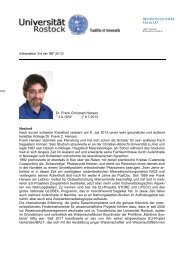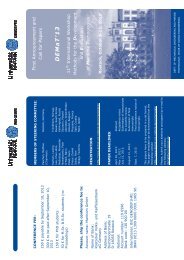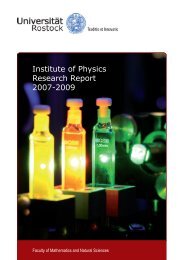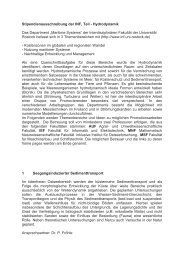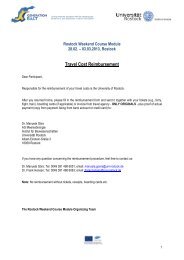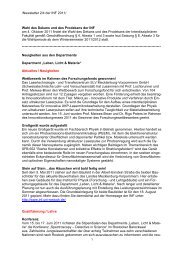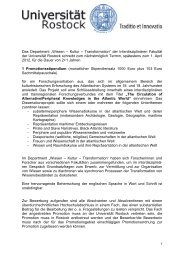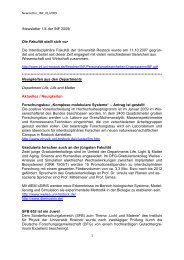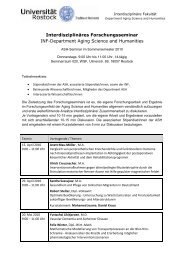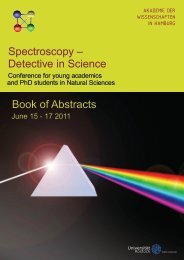Institute of Physics Research Report 2010-2012 - Universität Rostock
Institute of Physics Research Report 2010-2012 - Universität Rostock
Institute of Physics Research Report 2010-2012 - Universität Rostock
You also want an ePaper? Increase the reach of your titles
YUMPU automatically turns print PDFs into web optimized ePapers that Google loves.
<strong>Institute</strong> <strong>of</strong> <strong>Physics</strong><br />
<strong>Research</strong> <strong>Report</strong><br />
<strong>2010</strong>-<strong>2012</strong><br />
Faculty <strong>of</strong> Mathematics and Natural Sciences
4 Department <strong>of</strong> Science and<br />
Technology <strong>of</strong> Life, Light and<br />
Matter<br />
4.1 Overview<br />
In a world which is becoming ever more complex, innovative or even revolutionary<br />
solutions primarily require two things: An extremely high specialization and<br />
a conceivably close interaction <strong>of</strong> various scientific areas. More than ever before,<br />
new ideas and technologies are being based on interdisciplinary thinking. On these<br />
grounds in 2007, the Department ‘Science and Technology <strong>of</strong> Life, Light and Matter’<br />
(LL&M) has been established within the Faculty <strong>of</strong> Interdisciplinary <strong>Research</strong><br />
<strong>of</strong> the University <strong>of</strong> <strong>Rostock</strong>. Its activities search to connect scientific effort <strong>of</strong> the<br />
faculties <strong>of</strong> natural sciences and mathematics, agriculture, engineering sciences as<br />
well as medicine. Three further departments ‘Maritime systems’, ‘Ageing <strong>of</strong> individuals<br />
and society’ and ‘Knowledge – Culture – Transformation’ together with LL&M<br />
currently constitute the Interdisciplinary Faculty (INF), which is supported by the<br />
University and the state <strong>of</strong> Mecklenburg-Western Pomerania. The aim is to identify<br />
and strengthen fruitful research fields through an appointment policy that is<br />
consequently oriented towards pr<strong>of</strong>ile and strategy in order to foster international<br />
competitiveness.<br />
Fig. 4.1: Catalysis, Photonics, Medicine, and Simulation technology are in the core<br />
<strong>of</strong> the Department <strong>of</strong> Life, Light and Matter.<br />
203
4 Department <strong>of</strong> Science and Technology <strong>of</strong> Life, Light and Matter<br />
4.2 Program <strong>of</strong> the Department<br />
The department LL&M aims at interdisciplinary research and training in the fields<br />
<strong>of</strong> photon sciences, engineering and catalysis, regenerative medicine and numerical<br />
simulations. The program comprises activities within several faculties and institutes<br />
<strong>of</strong> <strong>Rostock</strong> University. Among those are the basic sciences — chemistry,<br />
physics and mathematics — as well as the more applied mechanical and electronic<br />
engineering, informatics, and life sciences. In addition, the Leibniz–<strong>Institute</strong> for<br />
catalysis (LIKAT), the Leibniz–<strong>Institute</strong> for atmospheric research (IAP), as well as<br />
the Gesellschaft für Schweißtechnik International (GSI) are significantly involved.<br />
The scope <strong>of</strong> the investigations reaches from fundamental problems like the interaction<br />
<strong>of</strong> light with matter via the development <strong>of</strong> chemical and agricultural as<br />
well as biologically relevant drug design for biomedical applications. Smart materials<br />
play an important role in all <strong>of</strong> these areas. One backbone <strong>of</strong> the Department<br />
LL&M is research on the impact <strong>of</strong> atomic and molecular properties onto macroscopic<br />
systems. Another focus is the question how atomic and molecular properties<br />
affect in macroscopic systems. Linked to this is the study <strong>of</strong> microscopic mechanisms<br />
that allow control by, e.g. light or molecular active substances. These operations on<br />
the atomic or nanometer scale can be used for the development and modification<br />
<strong>of</strong> new methods and materials. Potential applications in biomedical and technical<br />
areas are as numerous as fundamental insights into a highly interdisciplinary field.<br />
The University <strong>of</strong> <strong>Rostock</strong> already has established competences at the intersection<br />
<strong>of</strong> natural, engineering and life sciences. They serve as solid basis for the Department<br />
LL&M, being a condensation nucleus <strong>of</strong> an interdisciplinary high-technology field.<br />
Moreover, as the research has many links to technical applications it bears potential<br />
for a sustainable future growth sector.<br />
4.3 Contribution <strong>of</strong> the <strong>Physics</strong> <strong>Institute</strong> to LL&M<br />
Among the over 40 research groups within LL&M, 10 belong to the <strong>Physics</strong> institute.<br />
These are:<br />
Pr<strong>of</strong>. Dr. Thomas Gerber<br />
<strong>Physics</strong> <strong>of</strong> Nano- and Biomaterials<br />
Pr<strong>of</strong>. Dr. Boris Hage<br />
Experimental Quantum Optics<br />
Pr<strong>of</strong>. Dr. Oliver Kühn<br />
Molecular Quantum Dynamics<br />
Pr<strong>of</strong>. Dr. Stefan Lochbrunner Dynamics <strong>of</strong> Molecular Systems<br />
Pr<strong>of</strong>. Dr. Franz-Josef Lübken Leibniz <strong>Institute</strong> for Atmospheric <strong>Physics</strong><br />
Pr<strong>of</strong>. Dr. Karl-Heinz Meiwes-Broer Clusters and Nanostructures<br />
Pr<strong>of</strong>. Dr. Fedor Mitschke<br />
Nonlinear Optics<br />
Pr<strong>of</strong>. Dr. Ronald Redmer<br />
Statistical <strong>Physics</strong><br />
Pr<strong>of</strong>. Dr. Christoph Schick Polymer <strong>Physics</strong><br />
Pr<strong>of</strong>. Dr. Heinrich Stolz<br />
Semiconductor Optics<br />
204
4.4 Current Activities<br />
4.4 Current Activities<br />
In the period under review one focal point <strong>of</strong> LL&M has been the enhanced networking<br />
among the workgroups in different scientific disciplines. At first, the members<br />
had to recognize their own benefits when participating in this interdisciplinary effort.<br />
With strong support by the University and the local government PhD scholarship<br />
funds could be granted to 14 students. All <strong>of</strong> them work on interdisciplinary topics<br />
and were coached by two supervisors from separate institutes. It is a success that<br />
numerous personalities have made an application for admission in the department<br />
as well as have written down research subjects suitable to LL&M. Members from<br />
five faculties as well as the IAP, LIKAT and GSI-SLV GmbH could be admitted<br />
thus after confirmation by the leading board <strong>of</strong> the Interdisciplinary Faculty and<br />
the Rector <strong>of</strong> the University, Pr<strong>of</strong>. Schareck.<br />
LL&M defines itself as a research department. Hence its main aim is the identification<br />
and establishment <strong>of</strong> topical research subjects in order to attract high-level<br />
scientists and enhanced third-party funding. In this respect the PhD scholarships<br />
serve as a glue money to strengthen initiatives setting up new research projects.<br />
Some major projects as well as few smaller ones could be either continued in the<br />
proximity <strong>of</strong> the department or be started. One major success has been the funding<br />
<strong>of</strong> a laboratory building specific for the Department LL&M. Approved by the German<br />
Council <strong>of</strong> Science and Humanities (Wissenschaftsrat) the scientific building<br />
will provide additional 2400 sqm <strong>of</strong> extensively equipped space. The topical focus<br />
<strong>of</strong> LL&M and the high standard <strong>of</strong> the contributing research groups made it possible<br />
to acquire 20 Mio. EUR funding for the new building and for equipment. With<br />
this an appropriate environment will be established for the interdisciplinary research<br />
and education in the Department LL&M. Activities within the disciplines <strong>Physics</strong>,<br />
Chemistry, Biology, Medicine and Engineering will be bundled in order to pursue<br />
the research on complex molecular systems. A central topic is the analysis, control<br />
and design <strong>of</strong> systems which are governed through processes on the molecular level.<br />
While most research groups are presently and will remain consistently located in<br />
their home institutions, the Department LL&M will get in the future additional<br />
capacity especially for Core Facilities and temporary project laboratories.<br />
Several larger projects with the contribution <strong>of</strong> LL&M research groups include:<br />
• Collaborative <strong>Research</strong> Center DFG-SFB 652 Strong correlations and collective<br />
effects in radiation fields: Coulomb systems, clusters and particles, see<br />
Sec. 3.1 for the overview. This project is centered at the <strong>Institute</strong> <strong>of</strong> <strong>Physics</strong>,<br />
with one project leader being from the Chemistry Department <strong>of</strong> the University<br />
<strong>of</strong> <strong>Rostock</strong> and three project leaders from the <strong>Institute</strong> <strong>of</strong> <strong>Physics</strong> <strong>of</strong> the<br />
University <strong>of</strong> Greifswald.<br />
• The Graduate School welisa - Analysis and Simulation <strong>of</strong> Electrical Interactions<br />
<strong>of</strong> Implants with Bio-Systems increases the communication among the<br />
205
4 Department <strong>of</strong> Science and Technology <strong>of</strong> Life, Light and Matter<br />
Fig. 4.2: Architect’s view <strong>of</strong> the scientific building LL&M<br />
PhD students within weekly colloquia, workshops, and other social activities.<br />
The doctoral students have the possibility to do their doctorate at the interface<br />
among electrical engineering, materials science, medicine, biology, physics and<br />
scientific computing. Along with this, occupational perspectives in research<br />
and industry <strong>of</strong> the medical technology are introduced to the young scientists<br />
through the high interdisciplinarity <strong>of</strong> their research topic.<br />
• The Helmholtz Zentrum München has set up a Virtual <strong>Institute</strong> for Complex<br />
Molecular Systems in Environmental Health (HICE) together with the University<br />
<strong>of</strong> <strong>Rostock</strong> and additional research partners. The project is funded by the<br />
Initiative and Networking Fund <strong>of</strong> the Helmholtz Association. HICE examines<br />
the biological effects <strong>of</strong> aerosols from relevant anthropogenic sources. Background<br />
are the health effects <strong>of</strong> aerosols from combustion processes (so-called<br />
particulate matter, i.e., emissions from car and/or truck traffic and heating)<br />
known from epidemiological studies. In addition to the exact chemical and<br />
physical analysis <strong>of</strong> aerosol composition, their biological effects are investigated<br />
using primarily innovative in vitro models <strong>of</strong> lung tissue.<br />
• The project Metrology for Bi<strong>of</strong>uels aims to provide validated and reliable<br />
methods with ensured traceability <strong>of</strong> the measurement results for physical<br />
and chemical parameters <strong>of</strong> liquid bi<strong>of</strong>uels, focusing on customer and industry<br />
needs, particularly on the automotive and aviation industry. A metrology infrastructure<br />
that underpins appropriate policies, stressing more sustainable use<br />
206
4.4 Current Activities<br />
Fig. 4.3: Status <strong>of</strong> the construction in the end <strong>of</strong> <strong>2012</strong>. In front: the physics teaching<br />
building. In the back: completed shell <strong>of</strong> LL&M.<br />
<strong>of</strong> natural resources, by the way <strong>of</strong> provision <strong>of</strong> sufficiently rigorous, independent,<br />
accurate and robust measurements, above dispute and legal challenge,<br />
usable by interested parties for compliance testing and regulatory enforcement,<br />
forms the basis <strong>of</strong> this project. This is <strong>of</strong> prime importance to consolidate a<br />
sustainable contribution <strong>of</strong> bi<strong>of</strong>uels to the European energy supply sources.<br />
• The combined research project Ionische Flüssigkeiten als Abschreckmedien in<br />
der Wärmebehandlung metallischer Werkst<strong>of</strong>fe is funded through the DFG and<br />
connects activities <strong>of</strong> the physics, chemistry and engineering (Keßler, Kragl,<br />
Schick)<br />
Furthermore, physics research groups and members <strong>of</strong> the department are involved<br />
in two cutting-edge <strong>Research</strong> and Innovation Projects in East Germany (‘Spitzenforschung<br />
in den Neuen Ländern’):<br />
• Regionale Entwicklung durch Medizintechnische Innovation und Spitzenforschung<br />
(REMEDIS). This collaborative project focuses onto the development<br />
<strong>of</strong> new implants for clinical applications. The consortium unites competence<br />
in the areas <strong>of</strong> the engineering sciences, medicine and natural sciences from the<br />
university. Other local, national and international institutes and companies<br />
are involved.<br />
• Light2Hydrogen - Energy for the Future. This research project explores new<br />
ways for hydrogen generation, boosting efficiency using nanotechnology and<br />
other novel technologies for a post-oil society. The production <strong>of</strong> hydrogen<br />
with the sole use <strong>of</strong> solar power would be a magnificent contribution to the<br />
generation <strong>of</strong> energy, which will not access fossil resources and will not pollute<br />
207
4 Department <strong>of</strong> Science and Technology <strong>of</strong> Life, Light and Matter<br />
the atmosphere. Co-funding by the state M-V is provided through the project<br />
Nano4Hydrogen. In close connection and intensive exchange with the sister<br />
project Light2Hydrogen, a unique basis upon the research topic photo-catalysis<br />
has been established.<br />
A variety <strong>of</strong> additional smaller and larger research projects constitute interdisciplinary<br />
work connecting the <strong>Physics</strong> <strong>Institute</strong> with other institutes and groups.<br />
The Department LL&M strives for increasing such concerted activities in order to<br />
strengthen the international competitiveness <strong>of</strong> the University <strong>of</strong> <strong>Rostock</strong>.<br />
208
<strong>Universität</strong> <strong>Rostock</strong><br />
MATHEMATISCH-NATURWISSENSCHAFTLICHE FAKULTÄT<br />
Institut für Physik<br />
D 18051 <strong>Rostock</strong><br />
Fon + 49 (0)381 498-67 00<br />
Fax + 49 (0)381 498-67 02<br />
institut.physik@uni-rostock.de<br />
http://web.physik.uni-rostock.de



